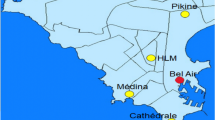Abstract
The present study assesses the time series data of air pollution in Nanded city since 2011 and is collected from source of Central Pollution Control Board, Government of India. In this study, autoregressive integrated moving average (ARIMA) time series forecasting approach is used for prediction of air pollution in Nanded city with two main locations. The main aim of this study is to forecast the air pollution for next 5 years by using ARIMA model with the air pollutants NOx, SO2, RSPM and SPM. The time series analysis is the predictive analytic technique gives us better results and this analysis is performed through free and open source software R. The prediction results obtained through ARIMA model highlight the increasing level of air pollution in Nanded city. In future, this study may be helpful to maintain the air pollutant within the permissible limit and in the development of smart city.

















Similar content being viewed by others
References
Bhardwaj R, Pruthi D (2016) Time series and predictability analysis of air pollutants in Delhi. In: 2nd international conference next generation computing technologies, IEEE, pp 553–560
Census report of India (2011) https://www.census2011.co.in/census/district/349-nanded.html
CPCB (2013) http://cpcb.nic.in/air-pollution/
Dastoorpoor M, Idani E, Goudarzi G, Khanjani N (2018) Acute effects of air pollution on spontaneous abortion, premature delivery, and stillbirth in Ahvaz, Iran: a time-series study. Environ Sci Pollut Res 25:5447–5458
Dimakopoulou K, Gryparis A, Katsouyanni K (2017) Using spatio-temporal land use regression models to address spatial variation in air pollution concentrations in time series studies. Air Qual Atmos Health 10(9):1139–1149
Gocheva-Ilieva SG, Ivanov AV, Voynikova DS, Boyadzhiev DT (2014) Time series analysis and forecasting for air pollution in small urban area: an SARIMA and factor analysis approach. Stoch Env Res Risk Assess 28(4):1045–1060
Gocheva-Ilieva SG, Ivanov AV, Voynikova DS, Boyadzhiev DT (2014) Time series analysis and forecasting for air pollution in small urban area: an SARIMA and factor analysis approach. Stoch Environ Res Risk Assess 28(4):1045–1060
Guo Y, Ma Y, Zhang Y, Huang S, Wu Y, Yu S, Cheng J (2017) Time series analysis of ambient air pollution effects on daily mortality. Environ Sci Pollut Res 24(25):20261–20272
Kadilar G, Kadilar C (2017) Assessing air quality in Aksaray with time series analysis. AIP Conf Proc 1833(1):020112
Kadiyala A, Kumar A (2014) Multivariate time series models for prediction of air quality inside a public transportation bus using available software. Environ Prog Sustain Energy 33(2):337–341
Kulkarni G, Nilesh D, Parag B, Wasnik P, Hambarde K, Tamsekar, Kamble V, Bahuguna V, Bahuguna V (2017) Effective use of GIS based spatial pattern technology for urban greenery space planning: a case study for Ganesh Nagar area of Nanded city. In: Proceedings of 2nd international conference on intelligent computing and applications. Springer, Singapore, pp 123–132
MPCB (2017) http://mpcb.gov.in/envtdata/demoPage1.php
Naveen V, Anu N (2017) Time Series Analysis to Forecast Air Quality Indices in Thiruvananthapuram District, Kerala, India. J Eng Res Appl 7(6):66–84
Su C, Breitner S, Schneider A, Liu L, Franck U, Peters A, Pan X (2016) Short-term effects of fine particulate air pollution on cardiovascular hospital emergency room visits: a time-series study in Beijing, China. Int Arch Occup Environ Health 89(4):641–657
Vanov A, Voynikova D, Gocheva-Ilieva S, Boyadzhiev D (2012) Parametric time-series analysis of daily air pollutants of city of Shumen, Bulgaria. AIP Conf Proc 1487(1):386–396
Wang KW, Deng C, Li JP, Zhang YY, Li XY, Wu MC (2017) Hybrid methodology for tuberculosis incidence time-series forecasting based on ARIMA and a NAR neural network. Epidemiol Infect 145(6):1118–1129
Yi W, Chan AP (2015) Effects of temperature on mortality in Hong Kong: a time series analysis. Int J Biometeorol 59(7):927–936
Yu C (2016) Research of time series air quality data based on exploratory data analysis and representation. In: Fifth international conference on agro-geoinformatics, IEEE, pp 1–5
Zhang H, Zhang S (2017) Forecasting of particulate matter time series using wavelet analysis and wavelet-ARMA/ARIMA model in Taiyuan, China. J Air Waste Manag Assoc 67:776–788
Author information
Authors and Affiliations
Corresponding authors
Rights and permissions
About this article
Cite this article
Kulkarni, G.E., Muley, A.A., Deshmukh, N.K. et al. Autoregressive integrated moving average time series model for forecasting air pollution in Nanded city, Maharashtra, India. Model. Earth Syst. Environ. 4, 1435–1444 (2018). https://doi.org/10.1007/s40808-018-0493-2
Received:
Accepted:
Published:
Issue Date:
DOI: https://doi.org/10.1007/s40808-018-0493-2




